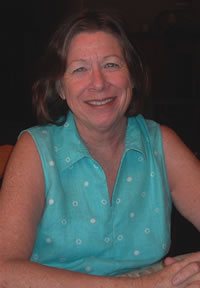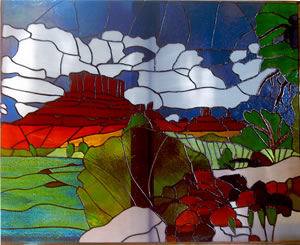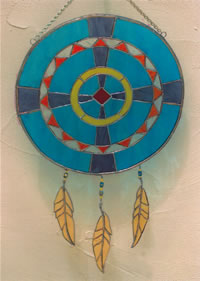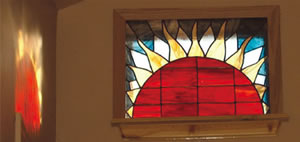 Most
art media clearly exist in either the second or third dimensions.
A painting generally lays flat and sculpture has infinite
points from which it can, and should, be viewed. Most
art media clearly exist in either the second or third dimensions.
A painting generally lays flat and sculpture has infinite
points from which it can, and should, be viewed.
One of the most interesting facets of stained glass art is
that it has...so many facets. First, there’s no right
side since both the back and front are meant to be viewed.
And though most pieces are two dimensional, they are intended
to allow light to pass through them. So, to fully contemplate
the effect of a piece of stained glass, you have to consider
this third dimension.
Unlike paint, whose colors remain the same despite varying
hues in different light, glass is translucent and its color
changes dramatically depending on what lies behind it.
Assembling a work of stained glass is like piecing a puzzle
together, but an accomplished artist must also figure in this
translucence and how to play it to the advantage of the work
of art.
An excellent example of this is a luminous sunset depicted
in a window designed and created by Glynda Marcus, a local
stained glass artist. Marcus used vividly colored glass, such
as azure, crimson and amber to depict a sun emitting undulating
rays partially obscured by the horizon.
Depending on the time of day, the weather and the season, the
colors of the transom change from brilliant to mute. The reflection
the window creates on opposing walls or the floor becomes a
complementary aspect of the work. Essentially, the sunset is
a performance piece, always presenting a new perspective of
the same image. It’s a glass act.
 Although
Marcus’ degree is in the humanities, not in the
fine arts, she has experience and talent. Over the last
few decades, she has created art through photography,
sculpture and pottery. Having always harbored an interest
in glass, she took a couple of courses to teach her the
basics five years ago. Although
Marcus’ degree is in the humanities, not in the
fine arts, she has experience and talent. Over the last
few decades, she has created art through photography,
sculpture and pottery. Having always harbored an interest
in glass, she took a couple of courses to teach her the
basics five years ago.
Marcus attributes her attraction to this particular medium
to two reasons. Harkening back to her childhood when she and
her mother often did jigsaw puzzles together, she enjoys, “making
the pieces fit.”
The other aspect that draws her to stained glass is the study
of light, which is the unifying element of so many art media. “I
wanted to manipulate light,” she explains, and found
that stained glass a perfect fit for her creativity.
Marcus demonstrates a mastery which goes beyond technique.
Stained glass can hover on the fringe between craft and art,
and it takes the spark of creativity to jettison a work into
the latter category.
Marcus creates her own designs and uses the many aspects of
glass, including color and texture, to manipulate the light
reflected through it.
 She
is fond of using complementary colors, such as orange
and blue or green and red, to create striking combinations.
She also displays a propensity to mix textures, such
as the beveled, water and clear glass used to create
the “Moab Man Petroglyph.” The Anasazi figure
is depicted in scarlet, representing the red rocks on
which these indigenous designs are found, and it stands
against a turquoise background of undulating glass, known
as “water glass,” which evokes the image
of a river. She
is fond of using complementary colors, such as orange
and blue or green and red, to create striking combinations.
She also displays a propensity to mix textures, such
as the beveled, water and clear glass used to create
the “Moab Man Petroglyph.” The Anasazi figure
is depicted in scarlet, representing the red rocks on
which these indigenous designs are found, and it stands
against a turquoise background of undulating glass, known
as “water glass,” which evokes the image
of a river.
Like many artists of the region, Marcus is clearly inspired
by the natural beauty surrounding her and the indigenous artists
preceding her. She has created vibrant depictions of Landscape
Arch and Delicate Arch, and figures from Anasazi petroglyphs
crop up frequently in her repertoire, including her logo.
In a piece entitled, “Shield-Dreamcatcher,” Marcus
uses contrasting colors to create an arresting image out of
a familiar one. The combinations of purple/yellow and turquoise/red
grab the eye, and when this dreamcatcher is viewed against
bright light, the colors radiate.
This work demonstrates Marcus’ competency in working
with glass. She makes the viewer forget that the medium is
glass. The feathers hanging from the shield look light, soft
and capable of being twirled by a breeze, when in fact they
are soldered shards of glass.
Marcus is equally comfortable working on small details as with
large scale. She has created numerous dragonflies, twelve-pointed
stars (that are truly 3-D) and candle holders. She incorporates
beads and charms in many of these ornaments, which enhance
the object and add a different translucence.
She mimics the look of ice crystals in one candle holder by
using elongated diamond shapes cut out of clear beveled glass
and piecing them together with clear textured glass. The sharp-pointed
border resembles icicles.
In glass inserts Marcus created for a two-door wooden gate,
she demonstrates this knack for blending textures effectively.
In these large works, she assembled pieces of glass that were
either beveled, rippled, or contained designs, like snowflakes,
within them. Although all the glass is clear, the varying textures
reflect light differently, giving the insert a complexity of
shapes and shadows.
Marcus’ work is more than the sum of its parts, literally.
In addition to the requisite manual labor involved in cutting
the glass, grinding its edges, painstakingly wrapping them
in foil, soldering them together, and finally cleaning and
polishing the piece, she imbues her original stained glass
pieces with artistry. Glass allows her to manipulate light
and work in the realm between the second and third dimensions.
Her pieces are never “finished.” Like a performance
piece, these glass acts are continually changing according
to the light penetrating through them and the perspective from
which they are viewed.
Don’t miss the show!.Glynda Marcus will be the featured
artist at Earth Spirit, starting on September 9. She can be
reached at (435) 220-0162 or at glynsglass@frontiernet.net.

|